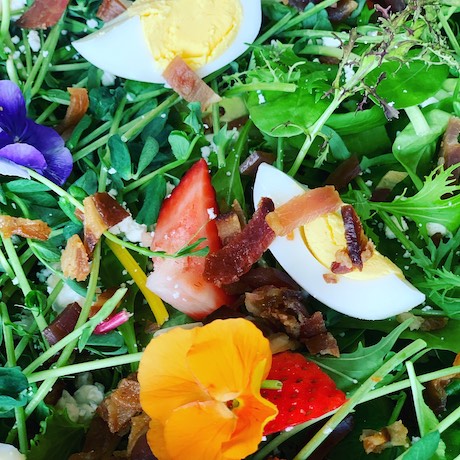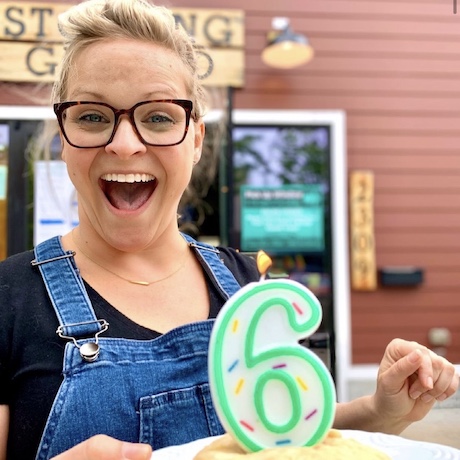How to Make a Basic Vinaigrette

When I sit down to write these Stylebook posts, I often reach out to friends to ask what tips they want. Elizabeth says again and again, “that dressing.” What she is referring to is the basic lemon vinaigrette we use at Stomping Ground on our greens and to finish most of our vegetable dishes. Just like all salad dressings and vinaigrettes, the recipe is incredibly simple. Once you memorize the basic methods and ratios, the dressing recipes you can create and adapt are nearly infinite.
Dressings are usually what take your carefully sourced (ahem) greens and vegetables to the next level. They come in three basic groups: vinaigrettes (emulsified oil and vinegar), mayonnaise-based (think of ranch, these usually contain an egg yolk and are therefore thicker and creamier), and dairy-based (with sour cream, buttermilk, etc.). Vinaigrettes are easy to learn and once you master the basics outlined here, you will never, ever need a recipe or need to buy a vinaigrette again.
Forcing oil and vinegar to combine is called an emulsion. At restaurants, we need a strong emulsion, so we typically whisk or use a blender to emulsify the ingredients. At home, you only need the oil and vinegar to stay together for about 30 minutes, so a jelly jar with a lid is perfect.
 Photo by: Christine Han
Photo by: Christine Han
Simply dress your salad (pro tip: dress your greens in a very large bowl, salt them first, pour the vinaigrette on the side of the bowl and gently swipe your greens through it). Store leftovers in the fridge and when it separates back into oil and vinegar, simply shake to recombine the vinaigrette before using.
The most basic formula for making a salad vinaigrette is one part vinegar or other acid mixed with two to four parts oil, depending on your taste. I personally like almost one to one point five, but I like my vinaigrettes very punchy. For example, you could use one tablespoon of cider vinegar and two to three tablespoons of olive oil. Or you could make a big batch of dressing and use 1/4 cup of vinegar mixed with 3/4 cups of olive oil. Or use ounces, or milliliters, or the side of a jam jar — this a ratio, so you can use the means of measuring the ingredients that you prefer.

Basics:
1 Part Acid
- • Vinegar; red, white, balsamic, sherry, rice, apple cider
- • Lemon juice or lemon juice combined with literally any other citrus. You do need lemon for sharpness though. If you combine with another citrus, do it 1 to 1 parts.
1/2 Part Emulsifier
- • Mustard (not yellow, but Dijon)
- • Mayonnaise
- • Honey
- • Egg yolk
2 to 3 Parts Neutral Oil
- • Canola
- • Grape seed
- • Safflower
1 Part Flavored Oil (optional) taste as you go
- • Extra virgin olive oil
- • Nut oil (I love hazelnut and almond oil)
- • Toasted sesame oil (add a very little at a time and taste)
- • Pumpkin seed oil
- • Avocado oil
Optional Flavorings
- • Minced shallots or garlic
- • Minced herbs (add just before serving so they do not turn brown)
- • Toasted and crushed nuts
- • Ground spices
- • Mashed anchovies (they don’t taste like fish, they taste like complex salt)
Add a pinch of salt. Shake, and taste. If it is too sour, add a bit more oil or optional flavorings. Shake again. Taste. Repeat until it tastes good!
- About the restaurant
If you wander down Del Ray’s, “The Avenue,” you won’t miss the farm-red building with a rustic fence bordering the patio. Stomping Ground opened two years ago and quickly became popular for its made-from-scratch biscuits and its neighborhood vibe. On weekends, excited guests line up before Stomping Ground opens hoping to be the first to get a just-out-of-the-oven biscuit or a fresh salad. Stomping Ground is mostly known for its fast casual breakfast and lunch but on Thursdays and Fridays they provide a full dinner service after 5:00pm. All meals are built from local, seasonal food that is organic whenever possible.
2309 Mt Vernon Avenue
Alexandria, VA 22301
703.567.6616








